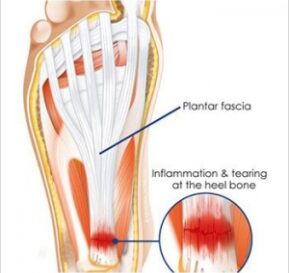Pain In The Bottom Of My Heel
Why Do I Have Pain in the Bottom of My Heel
We frequently see patients attending the clinic asking the question why is there pain in the bottom of my heel? The most common cause of pain in the bottom of the heel is a condition known as plantar fasciitis. This is a condition that feels like a stone bruise in the bottom of the foot. It is commonly caused by tight calf muscles, incorrect choice of shoes, an increase in body weight and or physical activity, in addition to other biomechanical factors. Plantar fasciitis is a condition that will affect men and women alike but seems to affect the older generation. We still see younger patients in their 20s or 30s at the clinic asking the question, what is this pain in the bottom of my heel, but the majority of the patients that we see are in their 50s and 60s. Plantar fasciitis causes pain in the bottom of the heel when we arise from our bed and take our first few steps of the day. Quite commonly the pain will subside within the first few minutes. The pain in the heel is also apparent after periods of being seated such as driving or sitting in a chair. “When I stand up and walk there is a significant pain in the bottom of my heel which usually causes me to hobble for some time”. In a small percentage of patients, the pain becomes extremely acute and can be described as excruciating. This will cause these patients to hobble throughout the day and begin to adjust the way they carry out their day to day activities. There is some confusion, and every now and then there will be a patient that explains to the podiatrist – I have a heel spur and this is causing pain in the bottom of my heel. However, focusing on a heel spur as the cause of pain is or can be described as old science. More recently, practitioners and podiatrists included, are now coming to terms with the fact that the heel spur is not the cause of pain but is an incidental finding. The pain is actually caused by inflammation within the plantar fascia, which is the condition mentioned above, plantar fasciitis.
Is the Pain in the Bottom of My Heel Due to Anything Else?
Some patients will ask the question, is there anything else contributing to the pain in the bottom of my heel? As with all medical conditions we have to be considerate of other possible causes. A differential diagnosis for plantar fasciitis is a superficial bursitis. Ultrasound imaging will reveal other soft tissue changes within the tissue under the heel. Bursitis is not as common but should still be considered.

How Long Will the Pain in the Bottom of My Heel Last?
Naturally, many patients feel anxious about their condition and will ask the question, how long will I have to live with this pain in the bottom of my heel? This is understandable, because as podiatrists we often see patients who have been suffering with heel pain for months if not years. This naturally creates anxiety. The majority of the patients that we treat feel better within days or weeks, and will usually make a full recovery before two months is up. Obviously, this is dependent upon the patient being compliant and can also be affected by the severity of the condition and how long the condition was around prior to treatment starting. At Sydney heel pain clinic there are a variety of treatments and the podiatrists will select one or a combination of treatments depending upon the patient’s individual circumstances.
Heel Pain Treatment
Is there a reliable treatment for the pain in the bottom of my heel and if so what is it? This is a common question and there is no short answer. The causes of plantar fasciitis are varied, and for this reason the treatments will also vary. Dr Google will provide an endless list of treatments including gimmicks and gadgets and a variety of home remedies. Some of these recommendations create short-term relief but do not contribute to the long-term healing. The podiatrists at the Sydney heel pain clinic will select a combination of treatments tailored around the patient and the specific individual findings on the day. More often than not, it is crucial to unload the plantar fascia in order for it to rest and recover. Unloading the plantar fascia is probably the single most important factor in its rehabilitation. Once the plantar fascia is unloaded, then there are other factors that will contribute to healing and allow the condition to settle. Other treatments are those such as shockwave therapy, strapping, calf muscle stretching, footwear changes and a modification to daily routine. In rare cases we need to use immobilisation boots. Commonly, the patients at the Sydney heel pain clinic will request prescription orthotics, made using a 3D scanner. These are an excellent way of unloading the plantar fascia. After using orthotics for a number of days, it is not uncommon for the patient to report to the podiatrist – the pain in the bottom of my heel is still there but is extremely mild and feels much better with the shoe liners in place. “Within 4 to 6 weeks the pain in the bottom of my heel subsided completely”.
I Have Pain in the Bottom of My Heel, Will Shockwave Therapy Fix it?
Shockwave therapy is a relatively new treatment in comparison to other more common podiatry treatments. The Sydney heel pain clinic currently receives many enquiries from patients asking – will shockwave therapy get rid of the pain in the bottom of my heel?
The short answer to this question is not necessarily. As mentioned above, there are many contributing factors to plantar fasciitis and it is crucial for the podiatrist to detect those causes and remove those problems. If we carry out a course of shockwave threapy but do not address the need to stretch calf muscles or change shoes for example, then there is a chance that the condition will persist.
That being said, shockwave therapy still remains an extremely beneficial treatment which stimulates blood flow and the turnover of new collagen. It can be described as something similar to pruning plants, whereby it knocks off the waste products and dead tissue and paves the way for new healthy cells. This helps to regenerate and strengthen the plantar fascia.
Summary
To summarise, there is more than one cause of pain under the bottom of the heel but the most common one is plantar fasciitis. All of the heel pain conditions that are treated at the Sydney Heel Pain Clinic are reversible and treatable. This article should not be taken as medical advice, but if you are reading this material and wondering – how shall I treat this pain in the bottom of my heel, you should contact a sports podiatrist, preferably one who specialises in heel pain.
SHOCK WAVE THERAPY
A reliable treatment for Achilles Tendonitis: LEARN MORE
Written by Karl Lockett





